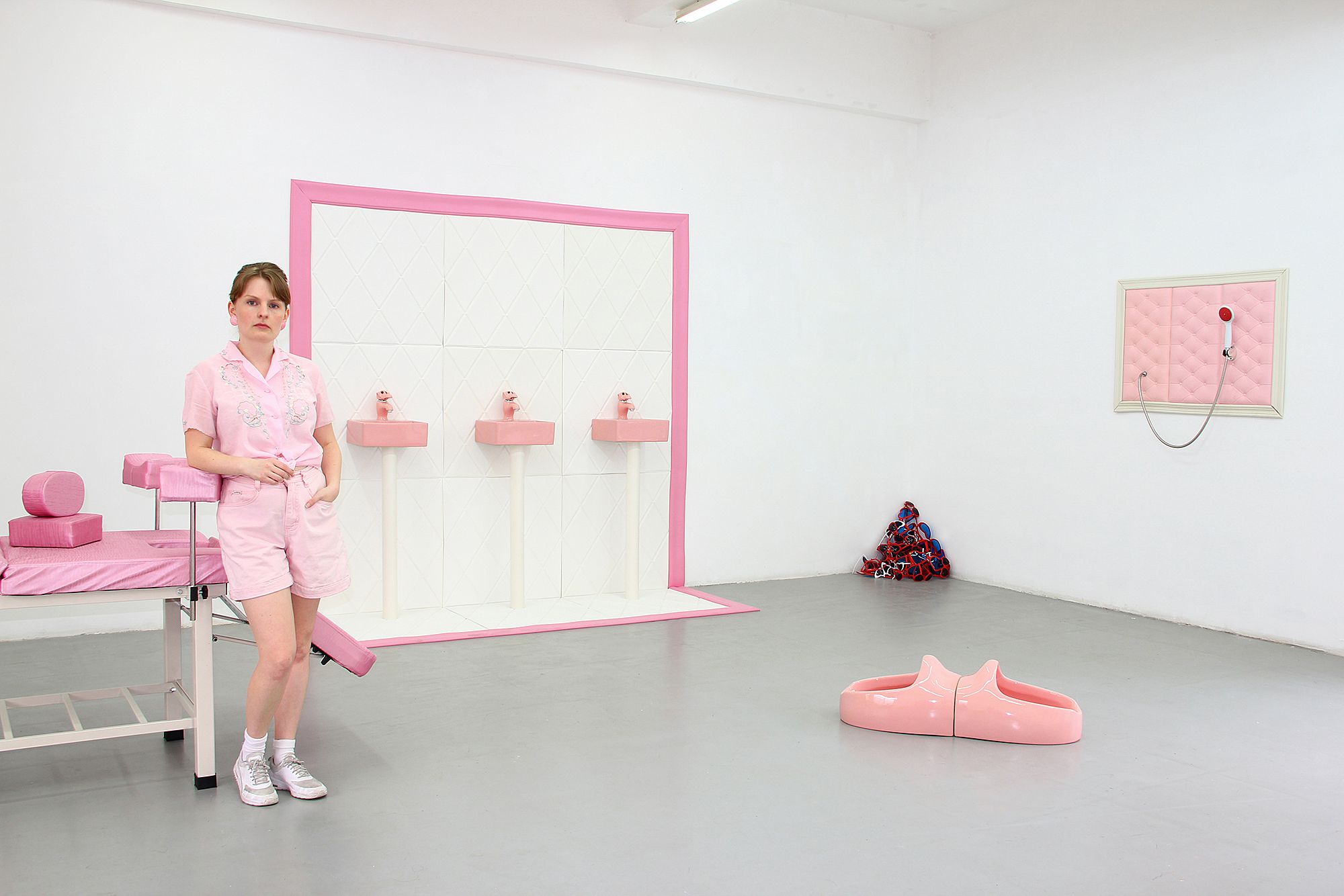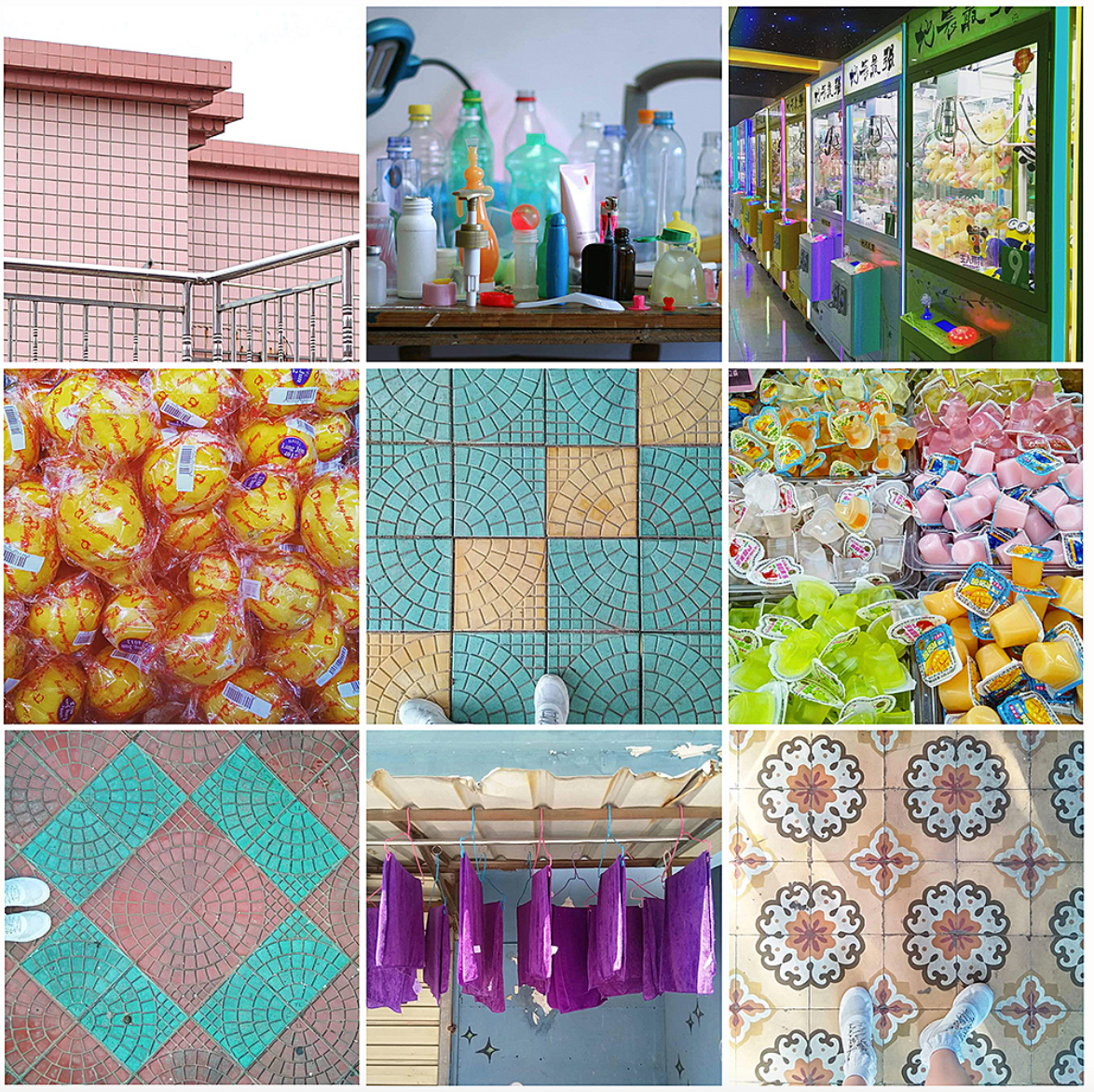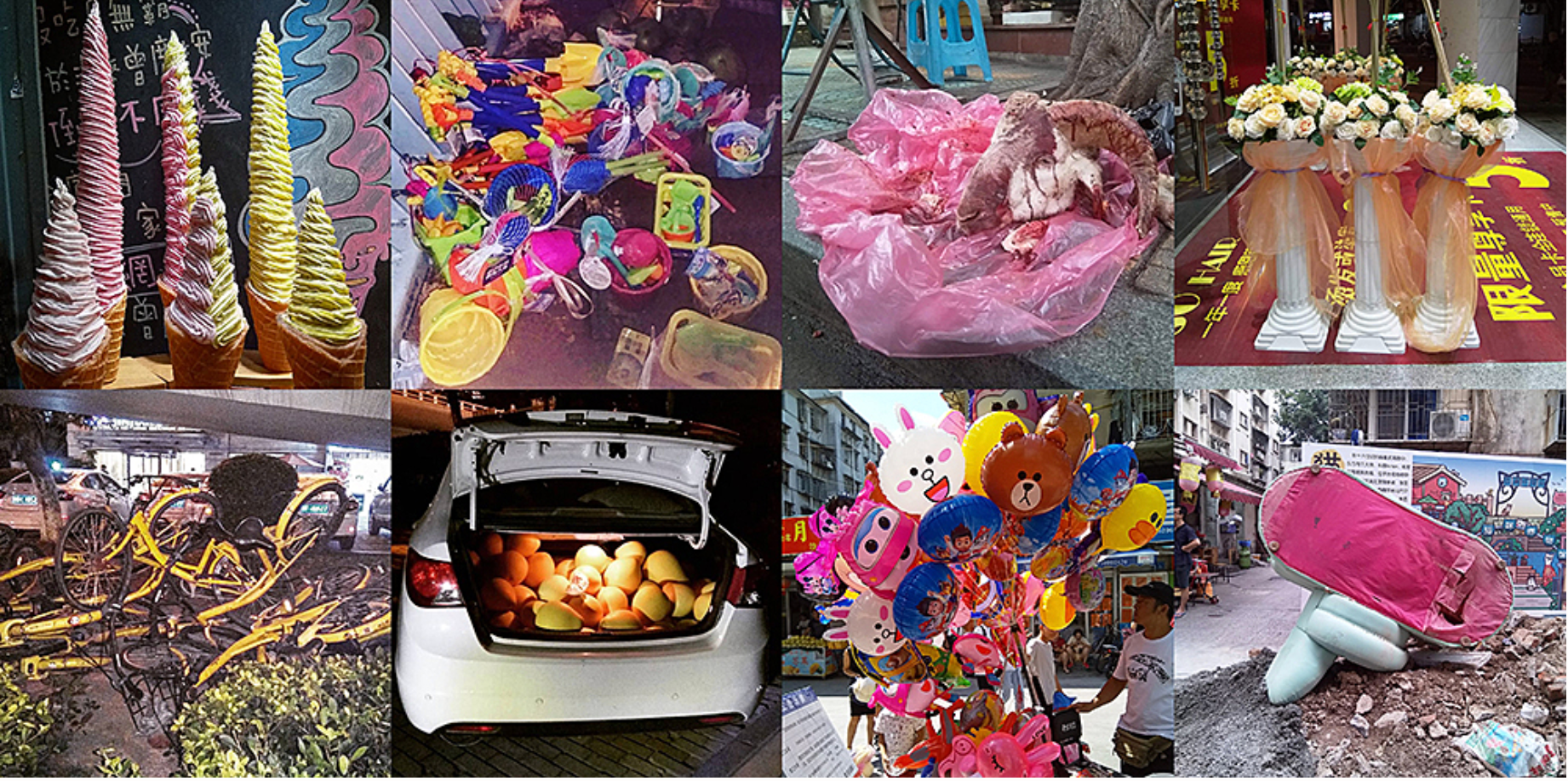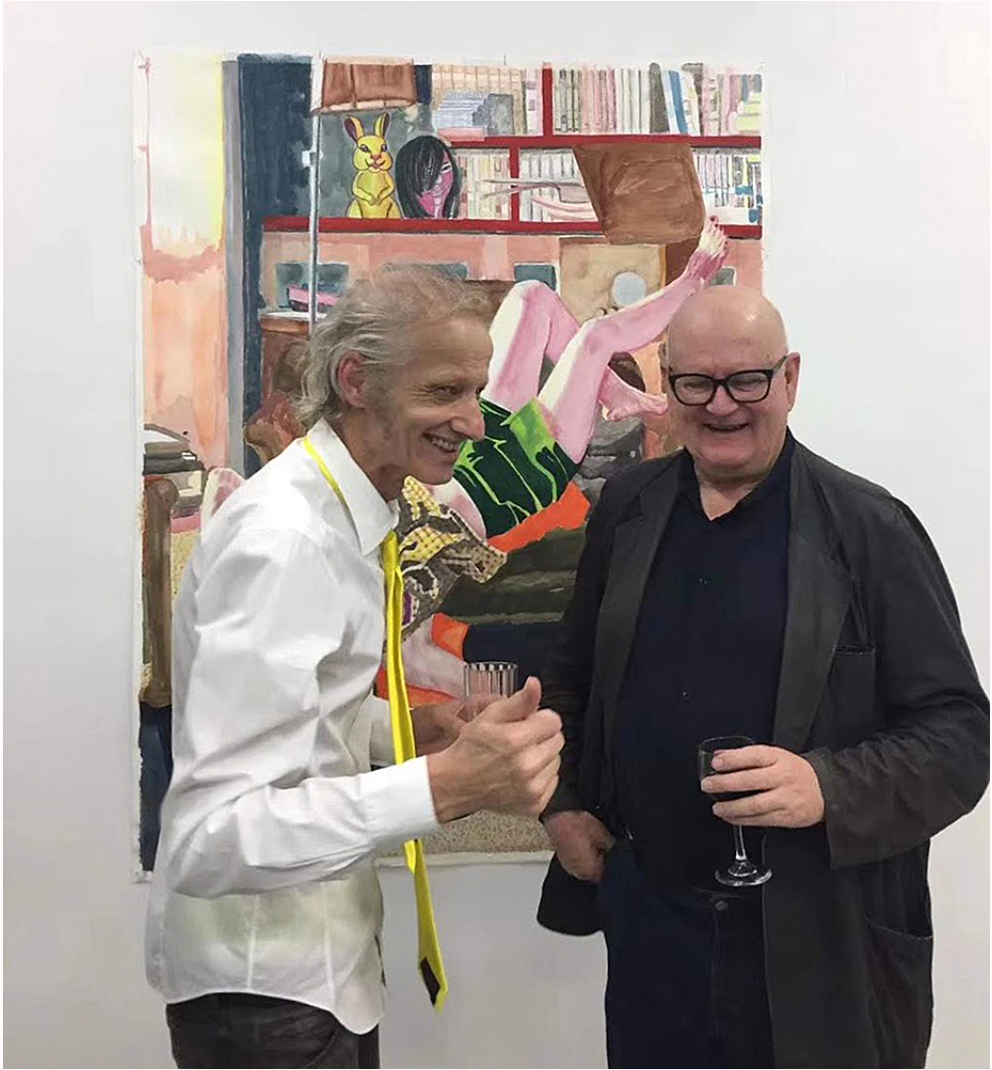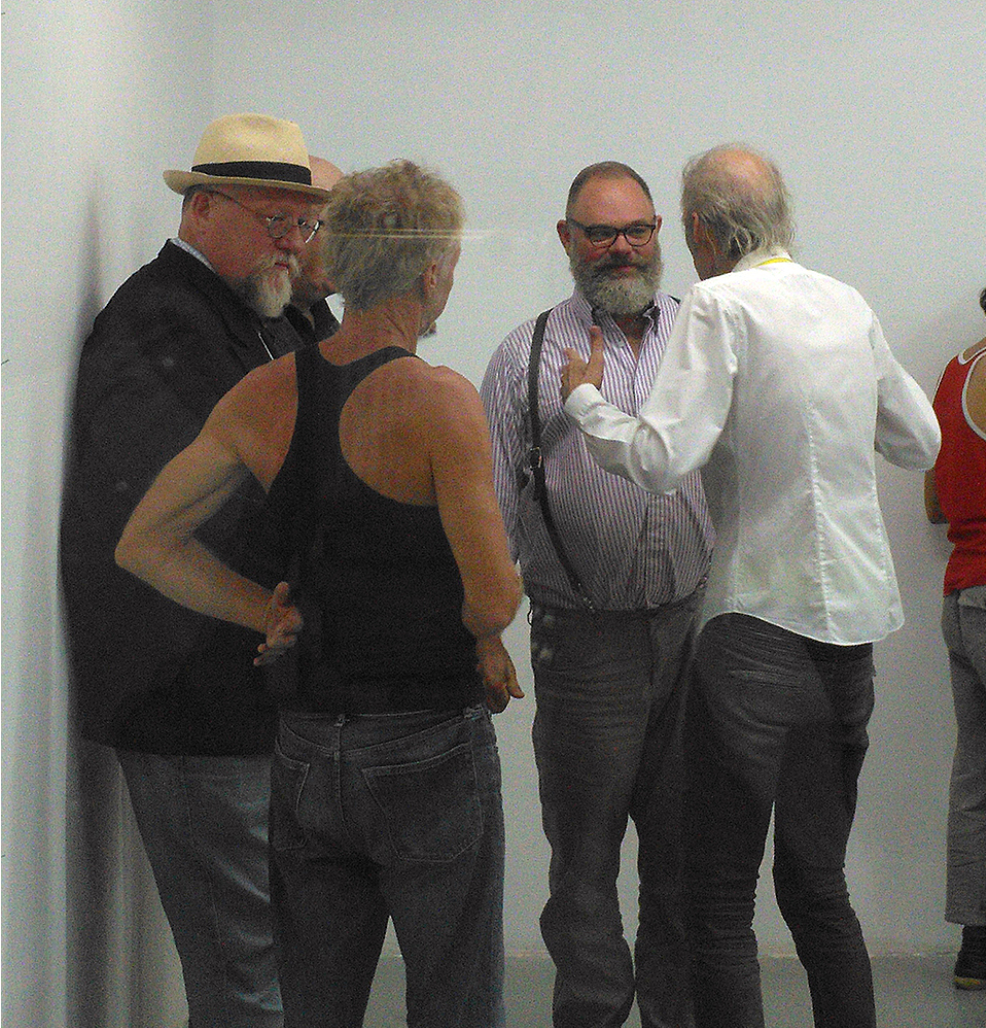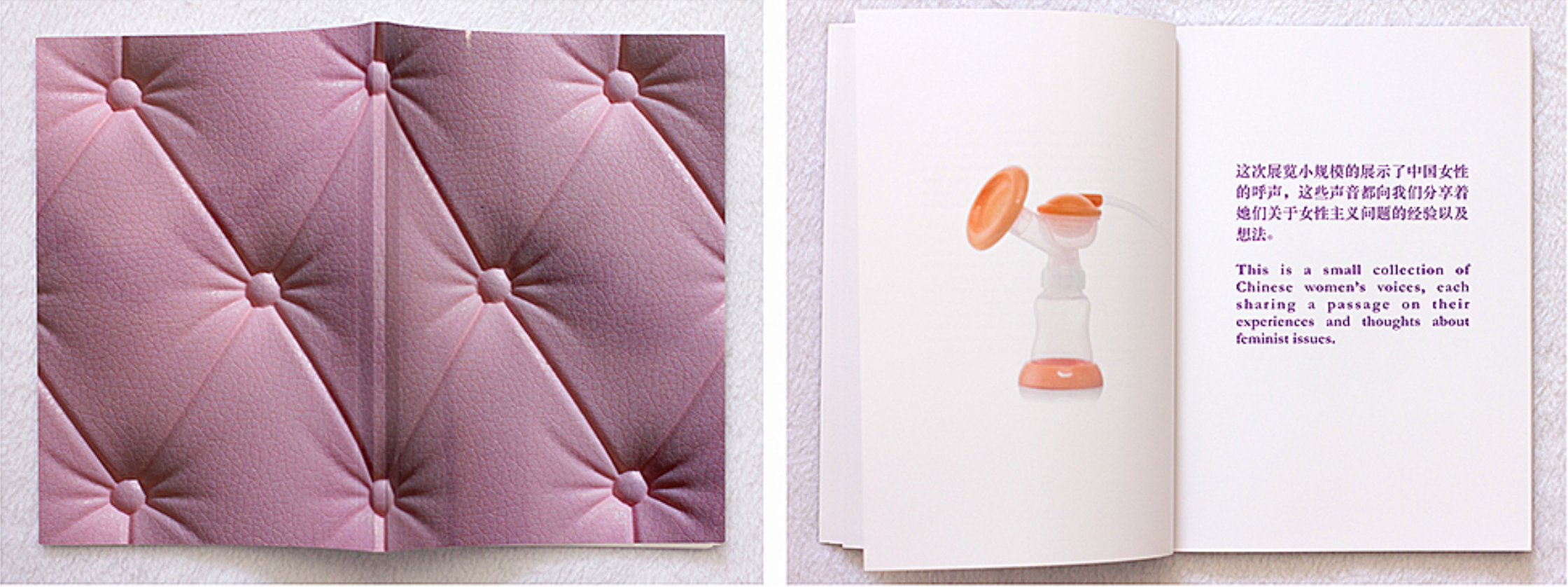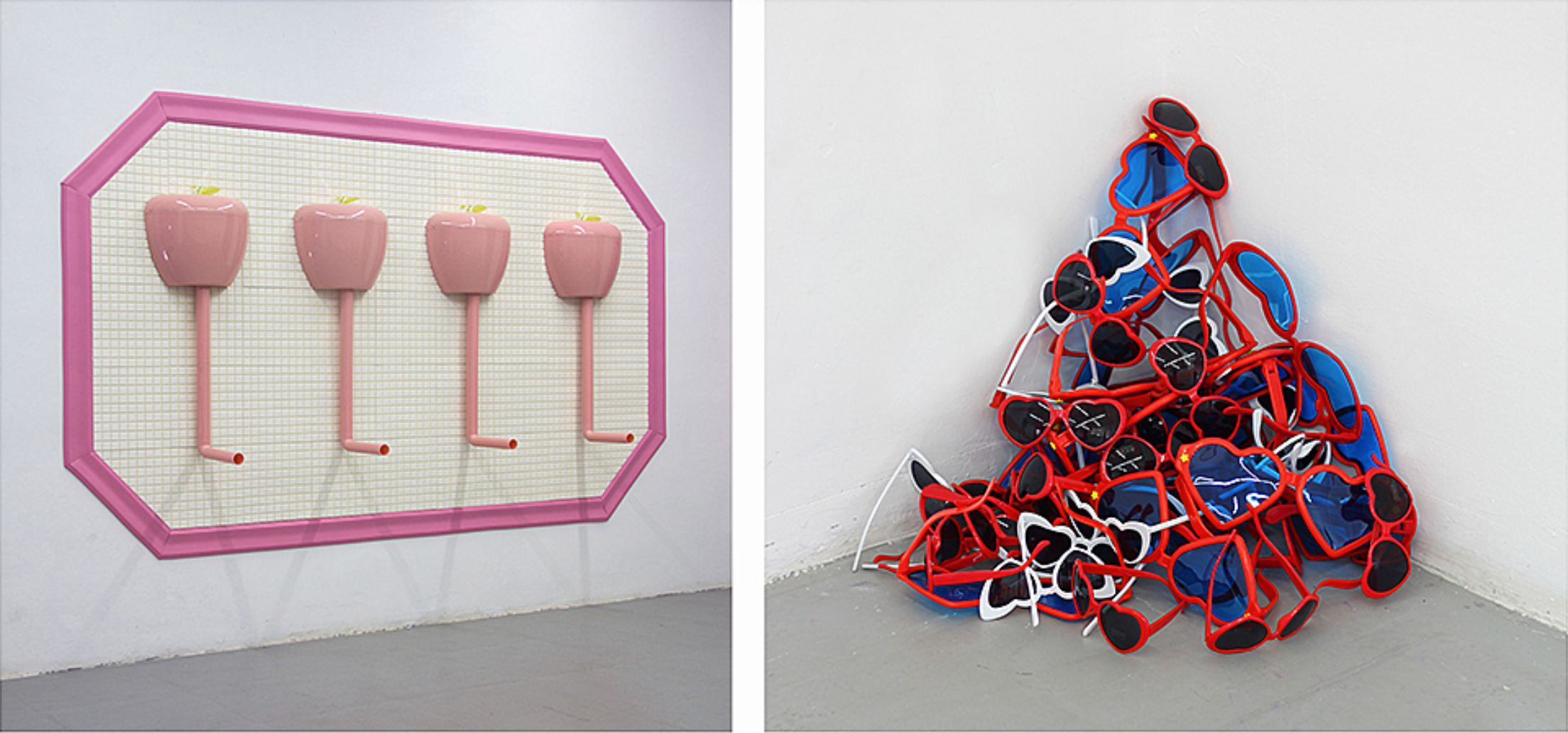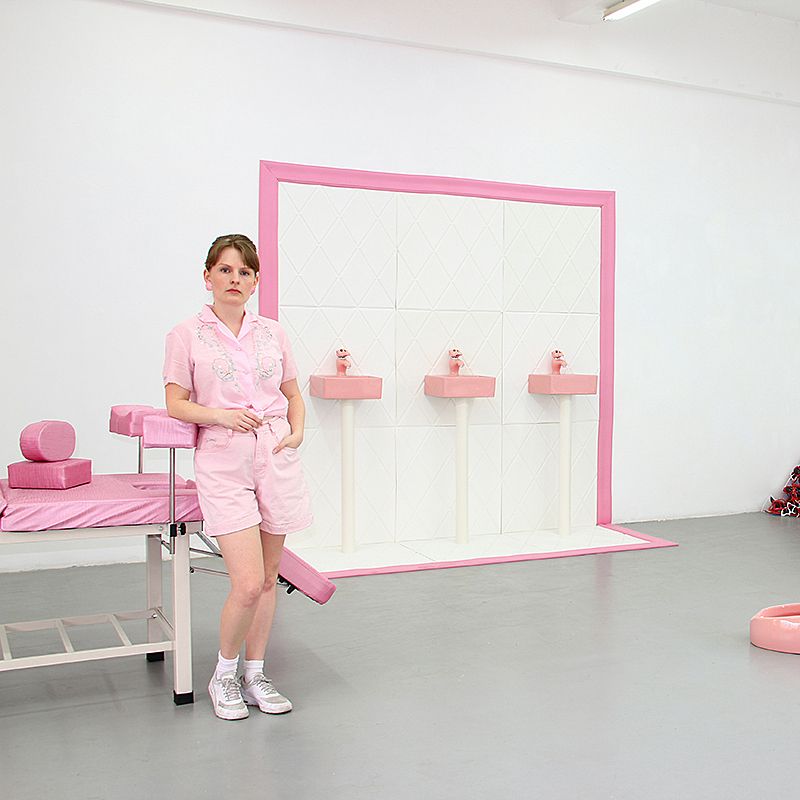The Power of the Pussy Bow: Fighting Back Against Rape-Art
On her first international art residency, Wellington artist Emily Hartley-Skudder was confronted by the overt sexism and abuse of power by another international artist. How do you call out sexism if it feels like no one wants to listen?
On her first international residency, Wellington artist Emily Hartley-Skudder was confronted by the overt sexism and abuse of power by another international artist. How do you call out sexism if it feels like no one wants to listen?
Please note: this essay discusses representations of sexual abuse
We arrived in Xiamen on the southeast coast of China on 1 September 2018. I had written and rewritten my project proposal for the Wellington Asia Residency Exchange (WARE) and on my third application I was lucky. It was my first ever residency and I was ready!
I was elated to discover pastel colours were everywhere and our apartment complex was covered in small, pink tiles. This was the place I had dreamed about. Everywhere you looked there was chrome, stainless steel, marble and granite. The entranceways were glorious. Nothing was restrained; patterns were everywhere. Bright colours seemed to be celebrated rather than dismissed as childish or girly.
Xiamen is a seaside tourist destination – basically a tropical paradise. There are palm trees lining the roads, and really fancy European cars everywhere, along with ride-share bikes, plastic electric scooters and classic rickshaws. Couriers deliver everything on their scooters, with boxes strapped sky-high. People sneeze loudly and gloriously. It was hot, joyous, confronting, and ultimately the most exciting place I had ever been.
It felt a little like my partner and I had reverted to childhood. We were nervous crossing the road. We relied on the one contact person from the residency like we relied on our parents as kids. We couldn’t really communicate except in gestures and one-off words, and we liked to select meals from menus with pictures. The people were so generous with their time; so patient, kind and genuine. Small interactions with welcoming people made my day when I was otherwise quite overwhelmed.
I loved this alternate reality where things were just that little bit different. A Mr Whippy-esque tune played every morning at 9:30am, but instead of alerting people to the proximity of frozen treats, it came from a large water tanker moving slowly down the road, watering the lush, tropical plants along the curbs and traffic islands. Even the power boxes were clad in fake green vines so they were in harmony with their environment.
We were living at the seaside, but there were no seagulls. The beaches were busier at nighttime. The shore would be packed with people, but no one laid out towels or sat down. People would line the water’s edge, but no one would be swimming. There were perfect-looking rocks every so many meters along the shore, with Chinese characters carved into them. Going past on the bus one day, I saw one being made – this rock was actually a hollow structure.
Our neighbourhood was the place to get your wedding photographs taken. Just before sunset, it would feel like there was a glitch in the matrix as there would be brides and grooms embracing every few metres on the beach and rocks, each with a photographer, stylist and lighting person perching around them. Déjà vu.
*
Artists on residency with the Chinese European Art Center (CEAC) are expected to work towards an exhibition to be presented in the organisation’s gallery. I began on my proposed project: collecting found items on the beaches, taking photos and researching the commercial oil-painting industry in Xiamen. I photographed the highly styled storefronts and the apartment buildings that were covered in pastel tiles – just like some of my installations. My studio table filled with colourful plastics. I loved that being on residency meant that everything that I did and experienced was connected to my practice. But my ideas were over-energetic and fragmented. I kept starting on a new idea without seeing the previous one through.
Our white privilege in Xiamen was uncomfortably acute. It became another reality where everything was exaggerated – the heat, the colours, the noise... and the Western imperialist arrogance of some foreigners. It was in this context that the presence of another artist on the same residency began to dominate my experience.
Pedro Bakker, a male Dutch artist born in 1952, makes large-scale paintings and drawings on paper, and also fancies himself as a performance artist. It is necessary to outline his demographic, as it is significant in the work he is now making: he is in his late sixties, married, white and university educated. He is forceful, loud, tall and self-important. He is the type of person who leans over you and gets just that little bit too close. We cannot separate this artist, his personality and his intentions from the work he produces.
Bakker is open about his obsessive interest in Chinese women and girls, and in the topic of sexual abuse. In a public artist talk during the CEAC residency, he explained that on a previous residency in China, he developed an infatuation with the young woman whom he was paying as his Chinese translator. He said he was obsessed with her, had sexual fantasies about her and became her stalker. As I later discovered, this was not the first time – his obsession with young Chinese women was unnervingly recurring.
In the exhibition invitation and press release that CEAC disseminated, Bakker wrote:
Several friends asked me why I am interested in China girls and their experiences of sexual harassment. First of all, I have to confess to the fact that I love China girls. But who is she? She’s not my girlfriend and she’s even not among my WeChat friends. I realize I love a type of a China girl, a form or an idea of beauty.
My project TO SCRRRROOOLLL is also about me and the China girl. I am the lover and the beloved China girl offers the beauty of her soul. I am a visual artist who is university educated as a philosopher.
For his exhibition, Bakker hired a young, female, Chinese dancer and developed a performance that re-enacted various stories of sexual abuse. The dancer was dressed first as a young child and then as a schoolgirl. She played the victim and Bakker the perpetrator. During this performance, Bakker cited the #MeToo movement. He referenced two female characters, Qingwen and You Sanjie, in the classical Chinese novel Dream of the Red Chamber (1791), and said he was ‘inspired’ by Stanley Kubrick’s Lolita (1963). To conclude, Bakker then appropriated and performed the true story of a high-school student who was assaulted by her teacher. Bakker, playing the ‘teacher’, followed the dancer around the gallery attempting to grab her, before offering to help with her studies in exchange for sexual favours. The performance ended with the two characters on the ground, Bakker arching over the dancer, forcibly clutching her as she pulled away. This strongly alluded to the female character being raped.
This was about power and intimidation. This was abuse disguised as art.
There was no trigger warning, no option of discussion, and the exit was blocked for most of the performance. The audience was completely deprived of their voices, forced to watch and left to suffer the consequences. It was an embarrassingly amateurish performance, but with this man in the role of artist, director and perpetrator, it showed the real potential for sexual violence. This was about power and intimidation. This was abuse disguised as art.
The toxic masculinity in the air was palpable after Bakker’s performance. An American man loudly joked to a woman (so everyone could hear) about how he needed to marry her because they “could no longer continue [their] sexual relationship like this”. The Chinese woman he was addressing clearly knew him, but appeared very uncomfortable and looked around awkwardly for help to deflect his comments. Another wealthy Dutch man handed out business cards for the bar he owned, which were literally shaped like penises. You cannot make this stuff up.
One of my shirt buttons had popped open and as I tried to discreetly do it up, an apparently famous, ‘elder’ Icelandic artist married to the director of CEAC made a comment about me taking my clothes off and doing another performance for him. He then berated me for not agreeing to come out drinking, saying I should “go home and put [my] feet in hot water and do knitting for [my] grandchildren” as he laughed in my face. Was I going crazy?
Please, I wanted to beg, don’t do this with art.
Despite what you may be thinking, Bakker is not some rogue exile. He has been funded multiple times by the Mondriaan Fund, which is the national Dutch public funding body for visual art and cultural heritage, equivalent to our Creative New Zealand. Their logo is on all of his press releases and posters. Dutch taxpayers have effectively paid for this harmful work to be made. It is symbolic that this (problematic) older, white, male artist continues to be handed public money by a national organisation that largely determines which artists are worthy of a voice. We are not innocent of this in Aotearoa, either.
*
I was scheduled to exhibit directly after Bakker, in the same gallery at CEAC. I did not want to do it anymore. Bakker had disrupted my romantic belief that art should be used for good: as an intelligent and powerful tool to subvert oppressive power structures. Please, I wanted to beg, don’t do this with art.
There is a large space in between being an entitled misogynist and being a rapist, but this grey area is terrifying.
People have since asked me if I had the chance to confront Bakker in person. Part of me thought maybe that could be good – but anytime I came close to encountering him, I fell apart. I became scared of leaving the studio/apartment in case I saw him around the complex. I could not escape the awful feelings he had triggered and their physical symptoms.
No, Bakker did not rape me. I personally was not his specific target or ‘taste’, as I am not a Chinese woman. Nor did he literally rape the dancer in the performance. There is a large space in between being an entitled misogynist and being a rapist, but this grey area is terrifying. I was hurting and I was scared. To me, this represented something much bigger.
Bakker’s shameless appropriation of the #MeToo movement was even more insulting due to the specific challenges faced in Mainland China by internet activists trying to share their stories. #MeToo does exist in China, but its use was very quickly censored by the government. Alternative hashtags have been created in an attempt to continue to speak out. The struggle is real.
My partner and I approached CEAC multiple times with our concerns about this artist and his behaviour. I told them that what had happened was very triggering and I was struggling with my mental health and feeling of safety. This was hard to admit.
As time has passed, I have realised that one of the hardest things about the situation was that I did not have this host organisation’s support, or even their basic respect as a person.
CEAC’s attitude was dismissive. They told me no one was harmed, that I was making a bigger deal out of it and I was actually making it worse by giving him attention. They said that there wouldn’t be any repercussions for CEAC, and that they didn’t want to talk about it anymore. This was a cowardly strategy to avoid any accountability for what had happened, and a blatant refusal to acknowledge the impact of supporting and exhibiting this artist’s work. As time has passed, I have realised that one of the hardest things about the situation was that I did not have this host organisation’s support, or even their basic respect as a person.
I felt victimised and silenced by Bakker and his supporters, yet I was in another country with very different social structures of criticism and gender. When can your own core values as an individual override cultural considerations? I truly believed Bakker should have been prevented from performing this work. But such obstruction would also act as yet another form of censorship to the people in Xiamen. I was acutely aware of my position as a white woman ‘pushing my own agenda’. I could not speak for Chinese women, or fully understand the layers of our cultural differences. But on the other hand, I clung to the belief that there are some universal aspects to women’s experiences that transcend cultural differences. Bakker is a Western artist, and CEAC is a Western organisation.
I was angry. I knew how defeated I would feel if I didn’t do my exhibition and just went home. I was also very aware of how little leverage I had in this situation – they’d hardly care if I pulled my show. Taking inspiration from Fresh and Fruity’s vinyl work Manifesto vol 1: Fresh and Fruity is a sexy new look (2014/2017) in The Tomorrrow People at Adam Art Gallery Te Pātaka Toi (2017), I realised that an effective way to critique what had happened could be from within. I negotiated with CEAC for a public apology that I would disseminate on the press release, posters and on the gallery window. They turned down most of what I proposed but agreed that I could write: “As a condition of this exhibition taking place, CEAC apologizes to those hurt by the previous artist’s promotion of sexist ideology.” It was something.
I then spent my time writing and meeting with Chinese women to discuss their thoughts about what had happened and to work out what to do next. I was scheduled to lecture at Xiamen University Art College about my practice. To conclude my lecture, I plucked up my courage and announced I was unhappy with the previous artist’s sexist exhibition at CEAC and that my upcoming exhibition would address this. I glanced up at the university professor who had organised my lecture – she was awkwardly looking down.
But the fact that I was framing my practice within gendered terms – discussing my use of feminine imagery, colours and the domestic space – seemed to open up the conversation for some of the young women in the audience. The students asked engaging questions and some came up to me afterwards to swap contact details and continue the conversation. This meant so much to me, at a time when I was barely holding myself together.
Putting myself out there like that meant some of these women knew where I stood. They shared some personal experiences with me, and I am deeply grateful for these confidences. I asked some if they would write a small passage on their experiences and thoughts about feminist issues. I collected these, and also some pieces directly responding to the previous exhibition. These were then made into a publication with Mandarin and English translations. This publication was part of my exhibition 蝴蝶结 Pussy Bow.
Pussy Bow publication, front cover and inside.
Pipe Dreams and Not Your Lolita.
Vag-o-matic Wet-Dry (after Koons) and Double Fountain, 2018.
Photos: Emily Hartley-Skudder.
I hoped Pussy Bow would somehow be a regaining of the women’s voices that were destructively silenced by the previous exhibiting artist – a feminist reclamation. Everything was pink. I got a gynaecology chair, complete with stirrups, upholstered with a satin sheen. I sourced a whole lot of heart-shaped sunglasses to reclaim the Lolita reference. I presented pink ceramic urinals and hand basins. I combined the clinical, sexual and the childlike; the hospital and the beauty salon. These were ideas that I had been processing for a while, and it was good to be driven by this circumstance to realise some of them. Ultimately, I was motivated to push my practice and make a statement – if only for the young women in Xiamen whom I had met. The fact I was in another country on a residency also meant I was able to shed painting-focused expectations of my practice.
I’m not really sure how my exhibition was received. Perhaps there was awkwardness because of the apology I had forced CEAC to make. The publication made some people who knew the previous artist very angry. Some of the men refused to see it as a genuine response to the way some people felt about the performance – they simply saw it as an attack and an attempt to dishonour Bakker. While I have to admit that I did want to do that, I was also using his behaviour as an example of a much larger problem.
To my surprise, a lot of people also thought it was unfair of me to only feature women’s voices in the publication. Speaking to some of the young women art students who contributed their writing, a common thread was that they felt making my exhibition overtly feminine would isolate the male audience and thus undermine the work. They suggested that I may have to use masculine aesthetics to stand up alongside male artists. I sensed a feeling of disappointment on their behalf due to my excessive use of pink… like I’d gone to war wearing a tutu. I guess they had a point, but hearing this also made me want to scream.
*
Wherever in the world a residency might be, it is hard to know what support artists can call upon when they are far from home
Before I went to Xiamen, I had read the Asia New Zealand Foundation’s ‘Briefing notes for artists travelling to Asia’. These included cultural guidelines such as:
Direct criticism should be avoided … attempting to assert opinions or ideas will not be appreciated and are highly unlikely to achieve what you want. You are more likely to lose respect and may have difficulty with any future requests for help.
Re-reading Asia New Zealand’s ‘briefing notes’ after my experience, I feel frustrated. What options does it give you if you do have a serious problem during your residency? This issue isn’t unique to Asia. Wherever in the world a residency might be, it is hard to know what support artists can call upon when they are far from home, if they have fallen out with their fragile support network. In my case, the host organisation only provided one contact person, whom I relied upon for essentials like drinking water, gas for cooking and keys for the apartment. Sometimes, the only feasible option felt like booking a flight home and getting myself to the airport. Due to lack of regulations, it seems many residencies such as CEAC simply operate as businesses and aren’t equipped to make artistic or ethical calls about whom they accept and what their gallery exhibits. I still shrink at the thought of how my fundamental beliefs and my general wellbeing were disregarded.
Partly through personality and partly through social conditioning from growing up female, I strive to please. I smile. I apologise – almost constantly. In public, I try to put on an outwardly bubbly persona, regardless of how I am feeling inside. I really want to be liked. Ironically, considering the ‘briefing notes’ on how you should not speak out, my experience in China forced me to do just that. I am proud that I finally found my voice, especially in the social climate of #MeToo. I realised the only reason I felt like I could do something in this situation was because I had been empowered by examples of other people speaking out in recent years.
It still hurts that I was supported only by very few. It hurts that some people only saw me as a troublemaker or as a little girl who didn’t know anything about art. I do still feel a sense of emptiness or failure, and also shame. I feel ashamed that I was so messed up by someone who did not literally assault me. But, I also know it is very important to share this story and honestly say how affected I was.
On the last day of my exhibition, two young women hugged and thanked me for doing something. They had been there and had watched Bakker’s performance, but didn’t have the words to describe why they felt bad, or know what to do. They said the publication I made articulated some of these things – saying what they couldn’t at the time.
This residency was one of the most incredible experiences I’ve had, and it will unavoidably inform my practice for years to come. It was a wake-up call and a privilege check. I am proud of the artworks I made – and I know these works would not exist had things played out differently. Difficult and often triggering topics do need to continue to be explored in art, but not by people who are simply perpetuating the harm.
Here is a quote from a young Chinese woman who wrote for my publication:
当我们承受不了时可以关上书,关掉一个网页,离开美术馆,但是我们不能假装问题不存在,痛苦不存在,我们也不能因为是“幸存者”就沉默。真可笑啊,我在这谈这么多,我妈妈也不知道。
When we cannot stand the pain, we can choose to close the book, turn off the web page, leave the gallery, but we can't pretend the problem doesn't exist, the pain doesn't exist, and we can't just be silent because we're survivors. That’s ridiculous. I’m talking about so much here, and my mother doesn’t know.
–Anonymous
NB: The Wellington Asia Residency Exchange (WARE) programme is funded by Wellington City Council and the Asia New Zealand Foundation. They will no longer be sending WARE residency recipients to CEAC.
Feature image: Emily Hartley-Skudder, self-portrait in CEAC Gallery.
Editorial note: This article has been amended to add acknowledgement for the artist taking inspiration from Fresh and Fruity’s work Manifesto vol 1: Fresh and Fruity is a sexy new look (2014/2017) printed poster, vinyl text, shown at The Tomorrow People (2017), curated by Tina Barton, Stephen Cleland and Simon Gennard, Adam Art Gallery, Wellington, NZ.
